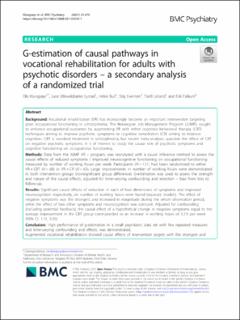| dc.contributor.author | Klungsøyr, Ole | |
| dc.contributor.author | Lystad, June Ullevoldsæter | |
| dc.contributor.author | Bull, Helen | |
| dc.contributor.author | Evensen, Stig | |
| dc.contributor.author | Ueland, Torill | |
| dc.contributor.author | Falkum, Erik | |
| dc.coverage.spatial | Norway | en_US |
| dc.date.accessioned | 2021-10-28T13:02:41Z | |
| dc.date.available | 2021-10-28T13:02:41Z | |
| dc.date.created | 2021-08-11T13:46:22Z | |
| dc.date.issued | 2021-07-23 | |
| dc.identifier.citation | BMC Psychiatry. 2021, 21 (1), 1-13. | en_US |
| dc.identifier.issn | 1471-244X | |
| dc.identifier.uri | https://hdl.handle.net/11250/2826338 | |
| dc.description.abstract | Background: Vocational rehabilitation (VR) has increasingly become an important intervention targeting poor occupational functioning in schizophrenia. The Norwegian Job Management Program (JUMP), sought to enhance occupational outcomes by augmenting VR with either cognitive behavioral therapy (CBT) techniques aiming to improve psychotic symptoms or cognitive remediation (CR) aiming to improve cognition. CBT is standard treatment in schizophrenia, but recent meta-analyses question the effect of CBT on negative psychotic symptoms. It is of interest to study the causal role of psychotic symptoms and cognitive functioning on occupational functioning. Methods: Data from the JUMP VR – program, was reanalyzed with a causal inference method to assess the causal effects of reduced symptoms / improved neurocognitive functioning on occupational functioning measured by number of working hours per week. Participants (N = 131) had been randomized to either VR + CBT (N = 68) or VR + CR (N = 63). Large improvements in number of working hours were demonstrated in both intervention groups (nonsignificant group difference). G-estimation was used to assess the strength and nature of the causal effects, adjusted for time-varying confounding and selection – bias from loss to follow-up. Results: Significant causal effects of reduction in each of four dimensions of symptoms and improved neurocognition respectively, on number of working hours were found (separate models). The effect of negative symptoms was the strongest and increased in magnitude during the whole observation period, while the effect of two other symptoms and neurocognition was constant. Adjusted for confounding (including potential feedback), the causal effect of a hypothetical change in negative symptoms equal to the average improvement in the CBT group corresponded to an increase in working hours of 3.2 h per week (95% CI: 1.11, 5.35). Conclusion: High performance of g-estimation in a small psychiatric data set with few repeated measures and time-varying confounding and effects, was demonstrated. Augmented vocational rehabilitation showed causal effects of intervention targets with the strongest and increasing effect from negative symptoms on number of working hours. Combination of therapy and activation (indirect and direct approach) might explain improvement in both cognition and negative symptoms, and shed some light on effective ingredients for improved treatment of negative symptoms. | en_US |
| dc.description.sponsorship | This research was funded by the Oslo University Hospital. | en_US |
| dc.language.iso | eng | en_US |
| dc.publisher | BMC | en_US |
| dc.relation.ispartofseries | BMC Psychiatry;21, Article number: 370 (2021) | |
| dc.rights | Navngivelse 4.0 Internasjonal | * |
| dc.rights.uri | http://creativecommons.org/licenses/by/4.0/deed.no | * |
| dc.subject | G-estimations | en_US |
| dc.subject | Causal inferences | en_US |
| dc.subject | Vocational rehabilitations | en_US |
| dc.subject | Psychotic disorders | en_US |
| dc.title | G-estimation of causal pathways in vocational rehabilitation for adults with psychotic disorders – a secondary analysis of a randomized trial | en_US |
| dc.type | Journal article | en_US |
| dc.type | Peer reviewed | en_US |
| dc.description.version | publishedVersion | en_US |
| dc.rights.holder | © The Author(s). 2021 | en_US |
| dc.source.articlenumber | 370 | en_US |
| cristin.ispublished | true | |
| cristin.fulltext | original | |
| cristin.qualitycode | 2 | |
| dc.identifier.doi | https://doi.org/10.1186/s12888-021-03349-1 | |
| dc.identifier.cristin | 1925331 | |
| dc.source.journal | BMC Psychiatry | en_US |
| dc.source.volume | 21 | en_US |
| dc.source.issue | 1 | en_US |
| dc.source.pagenumber | 1-13 | en_US |

